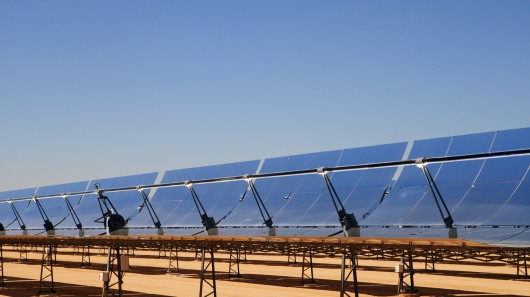CSP plants could run at 80 percent capacity (or better) throughout the year
June 24, 2014

A large, distributed network of concentrated solar power plants in desert regions could run at 80 percent full capacity year round (Photo: Shutterstock)
Researchers at the International Institute for Applied Systems Analysis (IIASA) have conducted a study to examine the potential for solar power to provide reliable electricity around the clock, every day of the year. The team found that a large, distributed network of concentrated solar power (CSP) plants in the Mediterranean basin or the Kalahari desert in southern Africa would be able to consistently run at 80 percent of maximum capacity or more throughout the year regardless of time of day, season, or weather conditions.
The potential to generate solar power in the Earth's deserts is essentially unlimited: there is more than enough land area to generate far more electricity than the whole world currently demands.
And yet, generating such vast amounts of power using photovoltaic (PV) cells would be unpractical, mainly because PV panels can't produce electricity at night, and are also subject to changing seasons and weather conditions. A power grid relying mostly on PV panels would need a very large number of batteries, which would drive electricity costs up.
One other promising approach to harvesting energy from the Sun is concentrated solar power, in which a system of mirrors and lenses focus a large area of sunlight onto a smaller area, heating a liquid which is then used to run a steam turbine and, finally, to generate electricity. The big advantage here is that the heated liquid itself can also be seen as an energy storage system. Intelligently controlling when and how this heat is converted into electricity enables such power plants to keep generating electricity whenever it's needed, even long after the sun has set.
In a recent study, researchers Stefan Pfenninger and colleagues simulated the operation of networks of CSP plants that also make use of thermal storage and optimized their siting, operation and sizing to meet what might be the realistic energy demand from the area.
"What we looked at was whether a solar power system based on CSP could provide electricity reliably," Prof. Anthony Patt, co-author of the study, told Gizmag. "Say you build 10 plants, each with some thermal storage, and with a combined peak output of 1,000 MW. How much of the time will you actually be able to provide 1,000 MW, or something like it? What we found is that a network of such plants, if optimized in terms of their placement and how they were operated, could indeed be operated such that they always provide between 800 MW and 1,000 MW whether it is summer, winter, day or night."
Crucially, according to the team's study, having the CSP plants store energy during the night or stretches of poor weather wouldn't add any cost in areas like the Sahara and the Kalahari deserts. In other areas, such as the Mojave desert, slightly less favorable weather conditions (such as periods of extended and extensive cloud coverage) would mean that, in order to consistently operate such plants at 80 capacity or better throughout the year, you would need to add extra mirrors and thermal storage capacity, which would push costs up.
The researchers say that a network of CSP power plants spread out over a large area makes sure that even if the sun doesn't shine for long periods of time, the system is still able to support large-scale energy needs by dispatching energy where it is needed.
This is the first detailed study of its kind to establish that it is indeed possible to build a power grid which relies primarily on solar energy and still provides reliable electricity around the clock, day at night, and throughout the year. Moreover, the costs per kWh might start dropping dramatically over the next few years.
"The costs of CSP, even in their least cost configuration, are currently higher than gas (roughly 10 cents per kWh, compared to about 5 cents)," Patt told us. "But that will almost certainly change if CSP becomes more mainstream, and it is reasonable to imagine that it will be as cheap as gas within the next 10 to 15 years. In a sense, our latest results provide a reason for energy system planners to push CSP to the point where this [cost reduction] will happen."
The study appeared yesterday on the journal Nature Climate Change.
Source: IIASA
Copyright © Gizmag 2003 - 2014